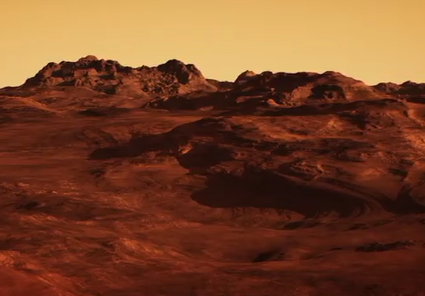(单词翻译:单击)
In some ways, Mars kinda sounds like a cool place to live, doesn't it?
从某种意义上讲,火星听起来是个有趣的居住地,不是么?
The red soil, the craters, the dormant volcanoes. Seems pretty scenic.
红土壤,陨石坑,休眠火山。风景看起来很漂亮。
And, if you chose the right real estate,
如果你选择了合适的房地产,
you could use one of the Viking landers as like, a lawn ornament or something.
可以使用某个类似“海盗”号火星探测器的东西作草坪装饰或其他用途。
But, of course, you'd have to be okay with temperatures around -60℃,
当然,你得适应零下60℃的温度
an unbreathable atmosphere, and deadly doses of radiation,
不宜吸入的大气和致命剂量的辐射,
which, for most people, are kind of deal-breakers.
这对大多数人来说都大煞风景。
But technology can do some fantastic stuff.
但技术可以做一些很棒的事。
And scientists who study terraforming, the science of transforming a planet to support human life,
研究地球化的科学家,地球化是指把行星改造成适合人类生活的科学,
have put a lot of thought into changing these things.
在改变这些事物上花了很多心思。
Turns out, with a few centuries worth of effort, we might be able to make Mars habitable for humans.
事实证明,用几个世纪的努力,我们能把火星改造得适宜人居住。
But, I'm not gonna lie to you, it would be really really hard.
但我不骗你,这真的真的很艰难。
A whole bunch of major things would have to change.
一大堆重要的事情需要改变。
Most importantly, Mars needs an Earth-like atmosphere.
最重要的是,火星需要类地大气。
There are a few theories about how to create one.
创造类地大气有几种理论。
And they have a lot to do with the planet's history.
它们与火星的历史有很大关系。
In its younger days, about 4 billion years ago, Mars was actually pretty similar to Earth.
火星早期,即大约40亿年前,和地球很类似。
It was warm and wet and had something of an atmosphere.
大气温暖湿润,富含某些东西。
That's because the Martian soil absorbed a lot of carbon dioxide and nitrogen that was floating around in the air.
这是因为火星土壤吸收了大量漂浮在附近空气中的二氧化碳和氮。
But then, active volcanoes recycled those materials by baking them out of the soil.
但随后,活火山通过把它们烤出来的方式循环这些物质。
So, they could be absorbed again.
因此,它们能够再次被吸收。
The result of this was an atmosphere that mostly stayed put.
结果是大气大部分不变。
Asteroids that kept hitting the planet helped out too, keeping it nice and warm.
不断撞击行星的小行星也帮助它们从地里出来,保持大气温暖美好。

And back then, Mars had a magnetosphere,
那时,火星有磁层,
a planetary magnetic field that protected the atmosphere from being stripped away by solar winds.
它是一种行星磁场,保护大气层不被太阳风所侵蚀。
But then the planet cooled and lost its magnetosphere.
但不久,行星变冷,失去了它的磁层。
There were fewer asteroid collisions, and its volcanoes stopped erupting.
小行星撞击越来越少,火山也停止喷发。
Without all that help, Mars' surface absorbed a lot of the compounds from its atmosphere.
在没有这些帮助的情况下,火星表面吸收了大量来自大气的化合物。
And lost most of what was left to solar winds, leaving a freezing, dry, barren, world.
失去了大部分留给太阳风的物质,留下了一个冰冷、干燥、贫瘠的世界。
Sounds pretty bleak, I know.
我知道,这听来很惨淡。
But, given what we know about Mars' history,
但是,考虑到我们对火星历史的了解,
with a little tweaking, we might be able to bring that atmosphere back.
如果稍加调整,我们就可以重新恢复它的大气。
Basically, we need to start a massive global warming effect, something that humans seem pretty good at.
从根本上说,我们需要开始大规模的全球变暖效应,这似乎是人类很擅长的事。
And scientists have come up with three main ways to do it.
科学家们想出了三个主要方法。
The first and easiest way might be to just build factories.
第一个最简单,建工厂。
That would basically turn carbon, fluorine, and sulfur in the Martian soil into greenhouse gasses,
这会使火星土壤中的碳、氟和硫变成温室气体,
and pump them into the atmosphere.
并将它们排入大气中。
This would unlock one of Mars' greatest assets when it comes to warming things up:
当火星变暖时,将开启火星最大的资产之一:
The thick layer of dry ice, or frozen carbon dioxide, that covers its south pole.
即覆盖其南极的厚层干冰或冻结二氧化碳。
An initial burst of greenhouse gasses could cause this ice to sublime directly into vapor,
最初的温室气体爆发可能导致干冰直接升华为水蒸气,
releasing carbon dioxide gas that would help trap more heat from the sun,
释放的二氧化碳有助于留住更多的太阳能,
in turn, releasing more greenhouse gasses.
这些太阳能反过来释放更多的温室气体。
But, all that would take a while, and it would be tough to supply those factories with the resources they'd need.
但这些需要时间,而且供应工厂所需的资源也很难。
So, another method might be to build giant, 200-kilometer wide mirrors in space.
那么,另一个方法可能是在太空修建一个200公里宽的巨大镜子。
They'd reflect sunlight onto the Martian icecaps,
它们会把太阳光反射到冰盖上,
raising the surface temperature and releasing that carbon dioxide.
导致火星表面温度升高,释放二氧化碳。
If neither of those ideas worked, there's always the possibility of bombarding the planet with asteroids.
如果这两种办法都不可行,用小行星撞击火星总有可能吧。
In this scenario, we'd capture asteroids on the edge of the solar system,
在此情形下,我们将捕捉太阳系边缘的小行星,
and use rocket engines to propel them into Mars.
并使用火箭引擎将它们推入火星。
The ammonia in the asteroids would act as a greenhouse gas.
小行星中的氨充当温室气体。
But, each asteroid would be like a 70,000 megaton hydrogen bomb.
但是,每颗小行星都像一个7万吨的氢弹。
So, aside from the obvious logistic problems,
所以除了明显的物流问题之外,
we'd have to do this way before humans were ready to set up shop there.
我们必须在人类准备在那里建立商店之前这样做。
And, even then, once the atmosphere had some greenhouse gasses in place,
而且,即使那时大气有一些温室气体,
it would still need an ozone layer,
它仍需要一个臭氧层,
a shroud of molecular oxygen that would absorb some of the sun's dangerous ultraviolet radiation.
即一种能吸收太阳危险紫外线辐射的分子氧气罩。
So, there would have to be, yet another step.
所以,还得再做一步。
Where we introduce organisms like cyanobacteria or lichens,
我们可以引入像蓝藻菌或地衣这样的生物,
which would help enrich the soil and release oxygen, that could eventually form ozone.
它们将有助于丰富土壤和释放氧气,最终形成臭氧。
Once the ozone layer was in place, the final ingredient for an Earth-like atmosphere could be added:Nitrogen.
一旦臭氧层出现,就可以添加类地大气层的最后一种元素了:氮。
This could be introduced by asteroid bombardments,
它可以由小行星轰炸产生,
or bacteria could extract it from the nitrogen-baring compounds locked in the regolith,
或者细菌可以将其从锁在风化层的含氮化合物中提取出来,
the rock layer just above the Martian bedrock,
风化层是火星基岩上方的岩层。
Easy-peasy. Mission accomplished, right? No. Not quite.
非常简单。任务完成了,对吗?没有。还没完成。
Mars would also need a way to hold on to its atmosphere,
火星还需要一种保持大气层的方法,
and keep it from being stripped away by solar winds.
防止它被太阳风刮走。
Basically, it needs to get its magnetosphere back, which is the biggest problem with terraforming.
说白了,火星需要有它的磁层,这是地球化的最大问题。
Because we really don't know how to do that yet.
因为我们还不知道该怎么做。
Earth has a magnetosphere which we're pretty sure is formed by liquid metals in the core.
地球有一个磁层,我们很确定它是由地核的液态金属形成的。
That create an electromagnetic field as they slosh around when the planet rotates.
当行星旋转时,它们在周围的晃动中产生了一个电磁场。
The same effect would happen on Mars if we could only figure out how to melt its core,
如果我们能弄清楚如何熔化火星核,同样的效果也会在它上面发生,
which appears to be solid metal, not liquid.
因为火星核似乎是固体的,不是液态的。
So, if anyone has any suggestions on how to liquify the middle of Mars, we're all ears.
因此,如果你对如何熔化火星核有什么建议,我们洗耳恭听。
In the meantime, thanks for joining me for this episode of SciShowSpace.
与此同时,感谢您收看本期的太空科学秀。
If you wanna learn how you can help us keep exploring the universe together,
如果你想与我们一起探索太空,
go to Subbable.com/SciShow.
就登陆Subbable.com/SciShow吧。
And don't forget to go to YouTube.com/SciShowSpace and subscribe.
也不要忘了登录YouTube.com/SciShowSpace点击订阅哦!


